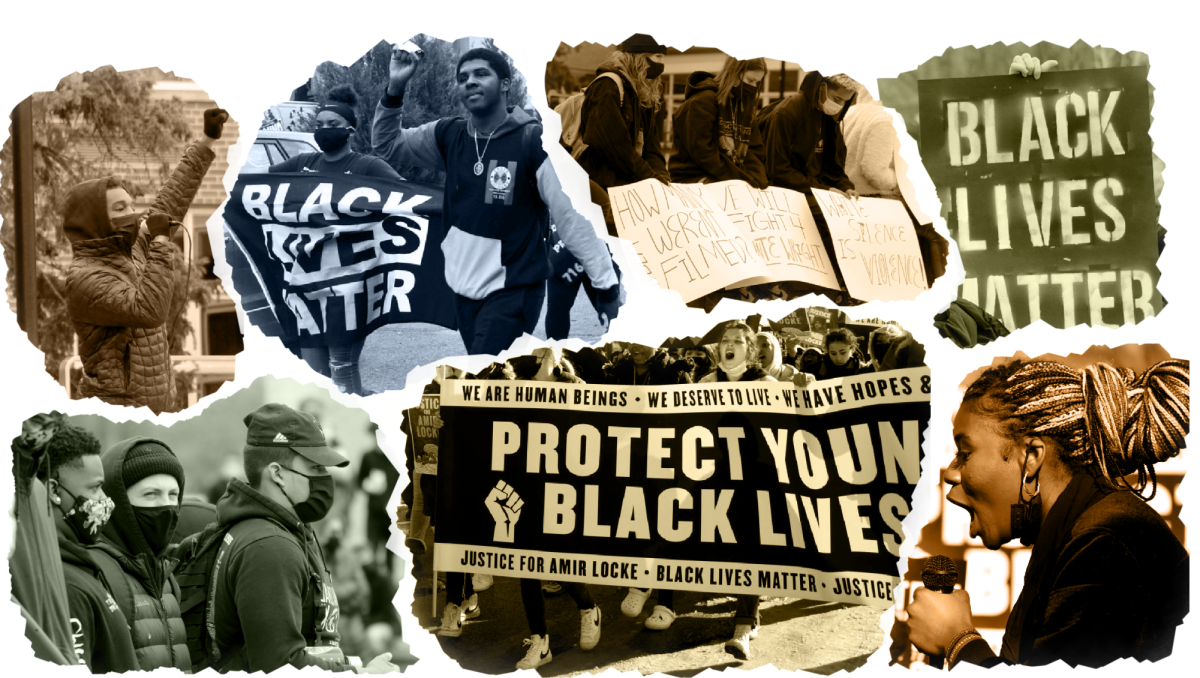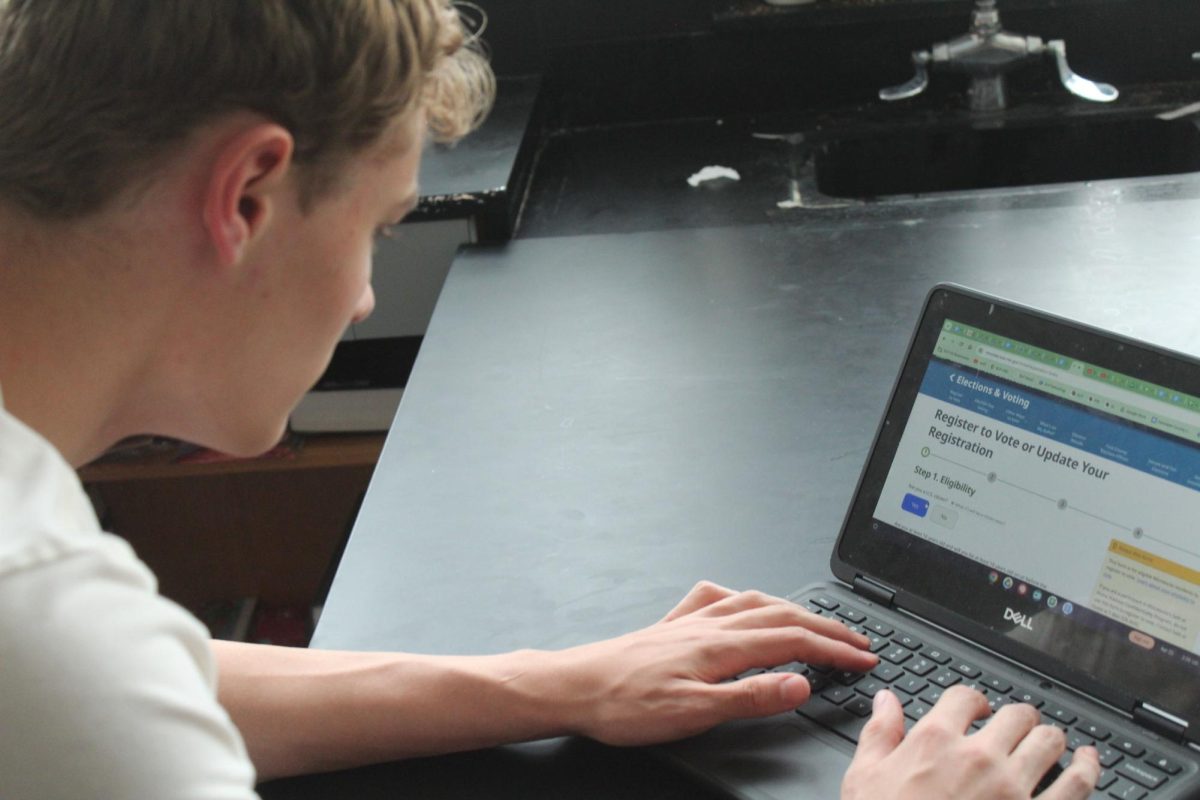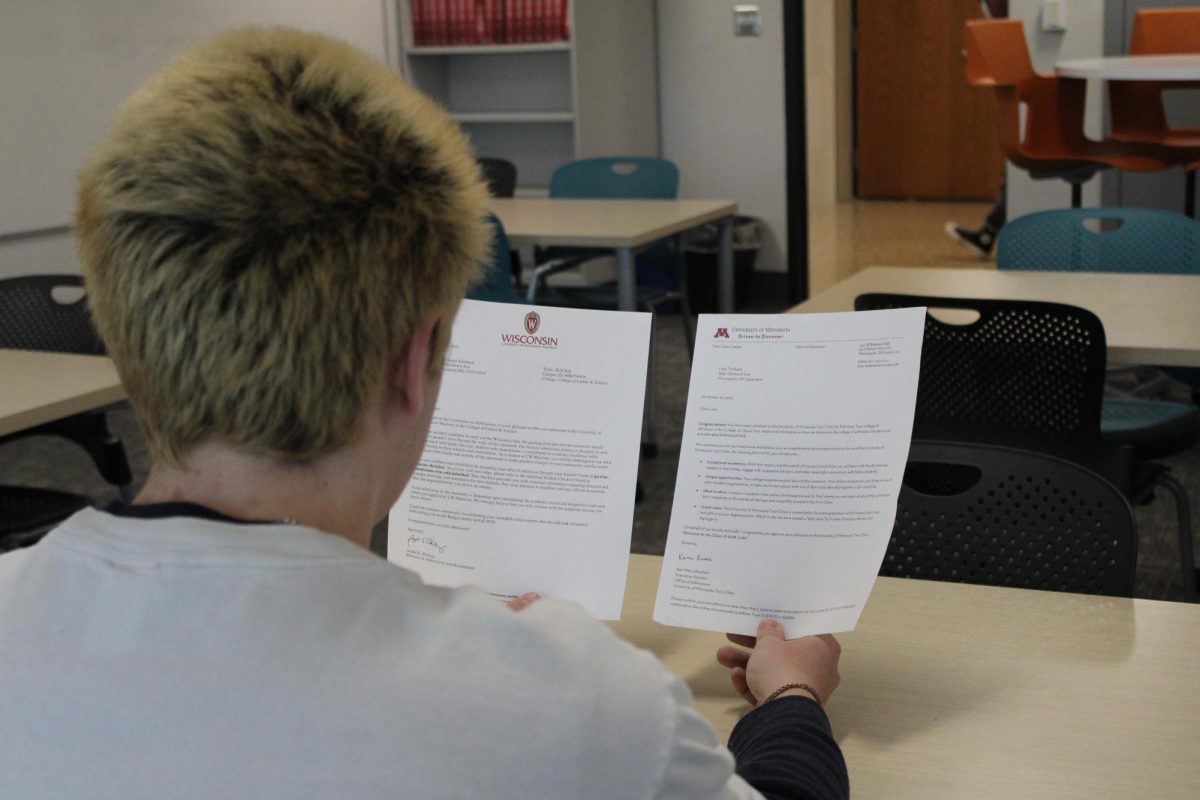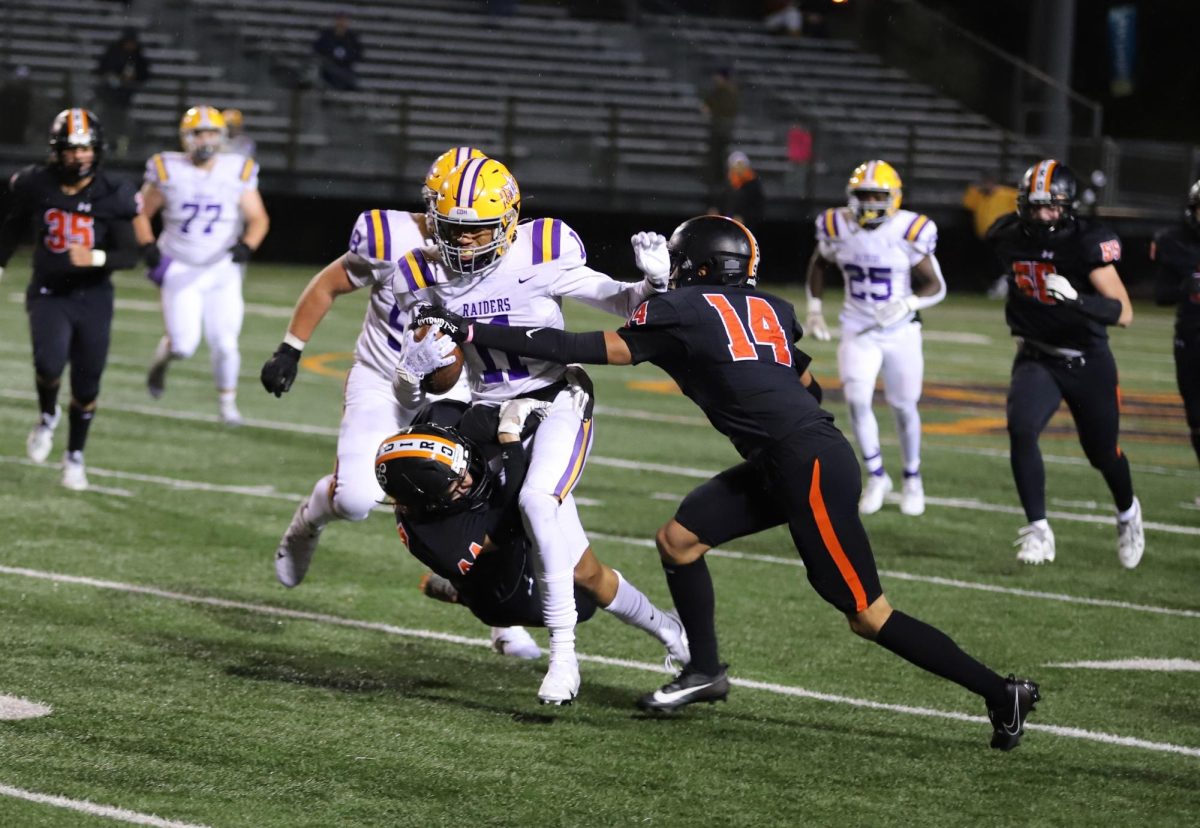Real change or rhetoric?
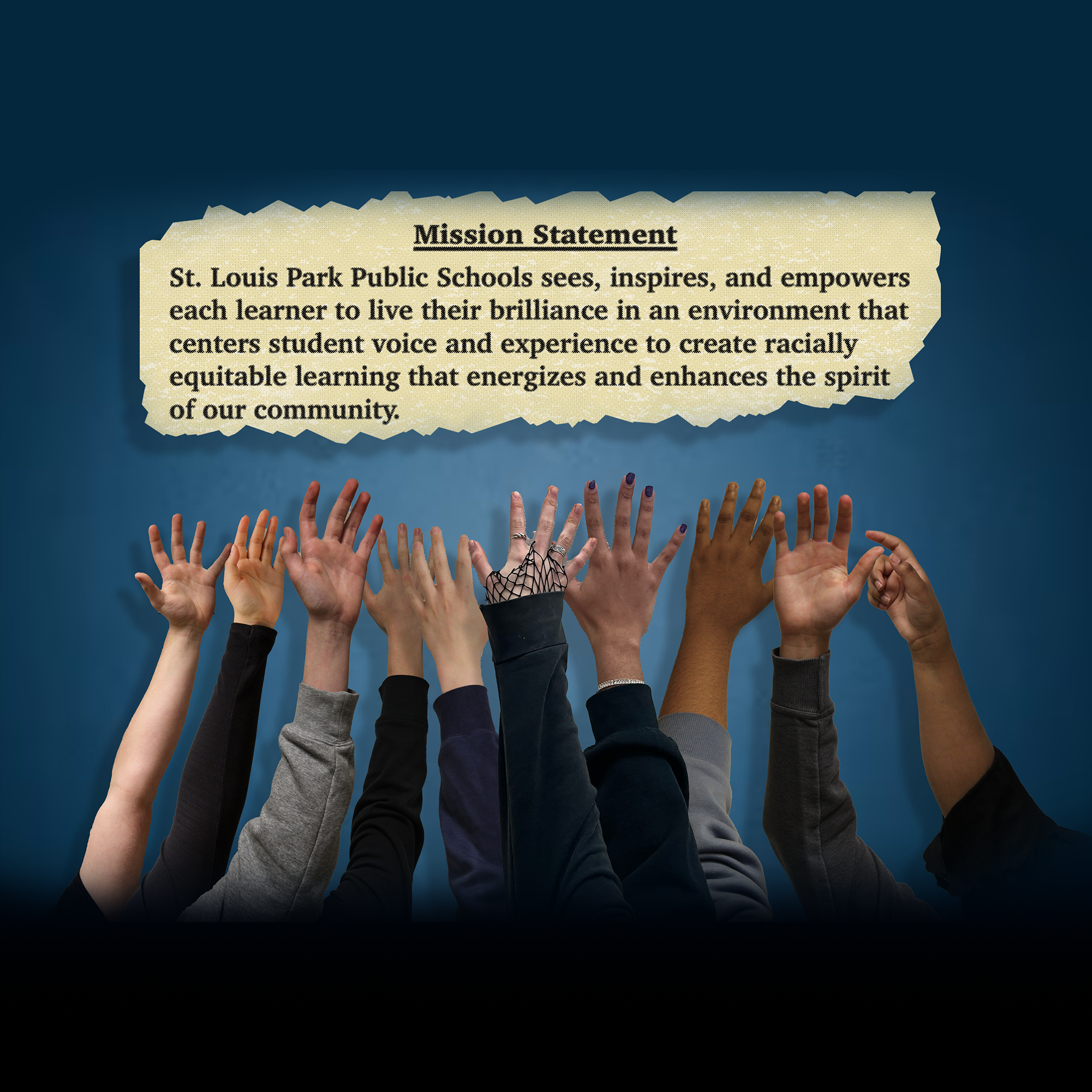
Park’s school district is operating on a 2020–2025 strategic plan for racial equity transformation using its official Mission Statement to guide areas of focus. According to social studies teacher Peter Gerdts, students being at the center of the Mission Statement is important.
“The Mission Statement says a lot about our aspirations as a school and where we want to go,” Gerdts said. “The hope is that it puts students and their humanity at the center of what we do, and asks us to think if our students and their humanity are not at the center of what we do, then we need to rethink what we’re doing.”
Department of Curriculum and Instruction lecturer at the University of Minnesota Dr. Abby Rombalski, said a Mission Statement and collective effort are tools for dismantling racist practices and perspectives.
“As long as we understand that racism is present and thriving in our schools, then our collective work means that we need to unlearn that and rebuild from that perspective, and a mission statement can help us to get to a new place,” Rombalski said.
Junior Kiran Alwy said the Mission Statement is insignificant due to its lack of implementation. She said the effects of the statement have not been made visibly clear to her.
“The Mission Statement is just a face — it doesn’t mean anything,” Alwy said. “It would mean something to me if I saw it being carried out. If I saw it being carried out, then it would mean more to me, but because I don’t see any changes that the Mission Statement is claiming it’s doing, then it doesn’t mean anything. Words without action mean nothing.”
According to the Director of Assessment, Research and Evaluation at Park Dr. Silvy Lafayette, the execution of racial equity as posed by the Mission Statement is easier said than done.
“Creating racially equitable learning is something that’s really easy to say and hard to do — it’s not just a St. Louis Park thing,” Lafayette said. “(Racism) seeps into the public school system, and it has always been present. If I could do anything different about our Mission Statement, I would accelerate dismantling other racist systems and structures, no matter what that is. There’s a long history of it, so it’s going to take some time. We’ve been strategic and we’ve made a lot of great moves.”
Senior Calvin Zimmerman said the Mission Statement fails to protect students of color.
“If this really had an impact, we would be making sure our students of color are safe rather than just allowing them to fail over and over again and being okay with that,” Zimmerman said. “That’s what this school does. I believe we allow our students of color to fail.”
In December of 2023, Park began their search for a new superintendent. This search consisted of open community engagement Q&As and surveys. Dr. Lafayette said valuing student voice at Park has the potential to increase the amount of student advocacy.
“People thought that students were showing up to be disruptive — that was not the case. What I saw in the hallway was authentic in trying to understand why students were upset,” Lafayette said. “What I saw in terms of outcome in the following meeting was that we had school board members that listened. It was very beautiful and I was proud of that. If more students recognize that they have the ability to make a change or play a role in something as big as choosing our new superintendent, that would make more people want to advocate for what they believe in.”
According to Zimmerman, actions over words are a demonstration of student-district collaboration. He said meetings meant to center student voices without action on behalf of the administration feel redundant.
“The best way that (administration) can demonstrate is by negotiating action, and then collaborating on the action with us,” Zimmerman said. “I don’t see a lot of the time where we meet with administration and it goes somewhere. Half the time when we meet with them, it feels like a PR event. It’s like, ‘Oh, we met with this group, check them off the list’ and then keep going with the regular day. (It) feels like we’re a box that they check and that’s disgraceful. It’s dishonorable, especially for your students. Follow through and listen to us. Listen to that feedback and do something with that because frankly, we are not happy when you don’t.”
Sophomore Tess Machalek said students’ lived experiences are unique to them, making students’ advocation significant in making progress.
“Only students know what students experience,” Machalek said. “Only students can truly advise adults about the problems that they see in their community because no adults do it — they’re just kind of guessing at it. They have no real, current, modern-day experience with it.”
Gerdts said while student feedback is sometimes difficult to hear, it should ultimately be a progress check that influences teacher growth and development.
“Students need to be our measurement of how (teachers) are doing. Students should feel good about school and know that their school is preparing them for the kind of future that they want — not my version of that future,” Gerdts said. “Teachers need to constantly hear from our students what they need and want, so we can keep working towards that. Student voice, the students, all activists also have a way of cutting through things and getting to some of that truth. It can be a hard truth to hear sometimes (but) students are the best people to tell us because they’re the ones experiencing school every day.”
Park is a district that offers open enrollment to students — an enrollment option that allows families to have access to schools that are not within their resident district. Zimmerman said student voice impacts the experience that open-enrolled students receive.
“We’re the ones being educated here. We’re not getting paid like the staff or administration, but it’s our school too,” Zimmerman said. “For the kids who are open-enrolled, this is their chance at a better education. I can’t speak for all of them — maybe they just prefer to go here — but for some kids in open enrollment, I can bet that this is their chance of a better education and we’re not doing that. Student voice has to be heard so we can step up and do that.”
Machalek said hearing underrepresented voices is crucial to creating a more progressive community moving forward.
“As we’re striving to be a more equitable community, we have to hear the voices of marginalized communities so that they are able to insert their input into their education and in their community so that we’re not repeating mistakes of the past and continuing to distance those voices,” Machalek said.
Social Studies teacher Emma Engebretson said AP (Advanced Placement) classes tend to be very white. She said the racial makeup of those classes sends a negative message to the rest of the school.
“I teach AP European History, and it’s very white,” Engebretson said. “We’re doing a disservice for our students of color and also for our white students. Our white students are in AP classes, where they’re really only seeing a majority of white students as they move from one AP class to another. Whether the message feels explicit or they’re internalizing that, the message is, ‘Oh, people in what we’ve deemed as advanced classes look like me and don’t look like a student of color.’ I think that is harmful when we’re trying to build people’s racial consciousness and understanding of race and how that’s impacting them.”
Alwy said she would feel comfortable in classes if more peers looked like her. She said it’s important that students feel encouraged to challenge themselves in classes.
“In my English class, I will read a book about an Indian family, and I’m the only brown person in that class — I’m the only person who experiences that on a personal level,” Alwy said. “If classes had diversity more reflective of our entire student body, I would feel more confident in my voice, and I would feel more supported in who I am. That’s why so many students don’t want to move up in classes or work harder in classes, because they feel like their voice isn’t supported. Having people who are similar to you around you makes it a lot easier to be confident.”
According to Engebretson, having few students of color in advanced classes is harmful to the education system. She said it’s important that students of color get together in affinity within these classes.
“For our BIPOC students, it feels really isolating to be in a classroom with all white students,” Engebretson said. “I often see students of color gathered together in affinity within our AP classes. I really do believe in affinity spaces. But it’s sad that there are only three to four BIPOC students in an AP class of 40, because if there were more BIPOC students, then it would feel less isolating, and it would feel more welcoming and more like every student in an AP class has the chance to succeed. And then, when students in the hall pass by, and they’re looking in an AP class with only a few students of color, that’s also sending a message as far as who ‘belongs’ in AP spaces and who does not.”
Dr. Lafayette said Park’s Gifted and Talented program created a racially predictable environment starting at the elementary level. She said after working with students, educators were able to deconstruct the program into a more racially equal one.
“Gifted and Talented started in elementary school, where results from standardized tests identified a mostly white cohort of students,” Lafayette said. “That later translated into high school, where the kids in advanced classes were still mostly white. One of (YDA’s) recommendations was to dismantle the practice of using standardized data to determine which classes kids could sign up for. That would be an example of a collective effort, where adults partnered with students to create a much more racially equitable opportunity system.”
Dr. Rombalski said students must feel cared for and valued in classrooms for antiracist work to occur.
“Inside the classroom, it’s important that students are known and can be looked at in a lot of different ways,” Rombalski said. “For teachers to know how to proceed with communities of care allows students to know that they belong, and then race equity work can take place. If that first attention to students as full humans isn’t there, then it’s hard for any kind of learning or race equity work to continue. (Students) need to grow in their cultural competence and they need to be able to have critical consciousness to change the status quo.”
Dr. Rombalski said that Park has programs that create racially-conscious students. She said programs like these put students of color in places of decision-making that are valuable.
“There are some programs at Park that lay really important foundations for students,” Rombalski said. “In middle school, there is a required identity-based course, Keystone, taught by critically conscious teachers. There are after-school programs, like the YDA program, which is based on putting in some real critical theories. Centering of students of color within other spaces at Park, like decision-making spaces, is really important. They set good foundations for that work to continue.”
In 2022, Park implemented a land acknowledgment as a first step toward more recognition and respect toward Indigenous People and the land. According to Engebretson, restorative practices are another indigenous practice that can continue to bring indigenous voices into our community.
“Restorative practices are a way that we are trying to bring in indigenous communities into our space in a meaningful way that goes beyond our land acknowledgment,” Engebretson said. “Restorative practices are meant to be authentically and fully involved in a community that we really care about. It’s a way of being, centering care and love and repairing harm and building relationships in order to be able to hold each other accountable. If we were really able to commit to doing and leaning into restorative practices, then we would be able to really see everyone’s humanity and center everybody’s needs and wants as a collective. That would really build our racial consciousness and our capacity to be in community with each other.”
Machalek said restorative practices are important to develop a sense of community because they bring people together.
“Restorative practices play a huge role because it emphasizes essentially community building rather than community isolation. It emphasizes a way to come together as a community rather than separating.” Machalek said.
According to Junior Arun Ferrán-Sapatnekar, although Courageous Conversations have potential, they aren’t enforced in school.
“They’re well intended, but they’re really boring and no one ever wants to do them,” Ferrán-Sapatnekar said. “Realistically, probably more than half the teachers don’t even do them in class. It’s definitely something that could and should be in place but it needs better implementation.”
According to Alwy, some programs perpetuate racism because they keep perspectives independent from one another.
“Separate programs affect separate people,” Alwy said. “It is good to have that in our community but it’s also good to listen to others. All the programs we have contribute to racism because they keep people’s voices separate.”
Dr. Rombalski said to be reflective of anti-racist practices, accessing current policies and practices is crucial to making systemic change.
“I don’t know that there is such a thing as an anti-racist institution,” Rombalski said. “Institutions, at their core, are connected to systems, and racism as it functions is systemic. In order to make Park or any place more reflective of anti-racist practices, they need to examine relationships, infrastructure, practices and beliefs.”
According to Dr. Lafayette, collective effort in making productive progress is not easy and should include various perspectives when conversing about race and racism.
“In an anti-racist institution, everyone is working in that institution and looking through the lens of race, racism, and understanding the history of where we’ve been, so that we can change the trajectory of where we’re going to go,” Lafayette said. “Everyone would be motivated and encouraged to engage in a conversation about race and racism, no matter how hard it is, and not just about the treatment of people of color or the perpetuation of whiteness in the system.”
Ferrán-Sapatnekar said working alongside people with different backgrounds can have an impact on one’s perception of others.
“When you interact (with) only people who have very similar backgrounds, you don’t get the chance to appreciate others and you don’t see what it’s like for other people,” Ferrán-Sapatnekar said. “You kind of end up in the echo chamber.”
Alwy said creating space to engage in courageous conversation without judgment will more heavily influence anti-racist practices moving forward.
“As a school, a step we can take is allowing people to have these conversations and to be able to talk about it openly without worrying about how it’s going to look or how it’s going to sound,” Alwy said. “The reason we couldn’t talk about it is because the school cared about how they looked, they cared about the reaction of other people rather than actually having a space for people to be vulnerable and be aware of what’s going on. We can always learn something from people who are different from us. When all these groups are secular, and they don’t talk to each other, they don’t lean on each other or even listen to each other. What are we doing? That’s not being anti-racist, that’s going back to the very things that we’re trying to stop.”
According to Gerdts, living an anti-racist mission is an ongoing process. He said for Park to fulfill their anti-racist mission, limiting spaces where racial assumptions can not be made is a step to move forward.
“The biggest marker that I want to see from a school that is living an anti-racist mission, and successfully doing that, at a high level will be the cutting down on spaces where it’s racially predictable,” Gerdts said. “Whether I think about the discipline records that we have, whether I think about honors or AP classes, whether I think about who’s in the hallway, and who’s not, who gets in trouble and who doesn’t — I want all those places to not be racially predictable. If I walk into a classroom, I don’t know whether it’s an advanced AP class, or a standard-level class. I want all students to have access to all of those spaces, and if those spaces are relevant for students, then how can we make more spaces for students so that they feel good about what they’re doing in the building? If we’re actually living an anti-racist mission or getting close to achieving that, our students will be the ones who tell us both in how they show up in school and what they want from school. Less of a destination where we can check off and say, ‘Yes, we hit it with a perfect day that raises school.’ It’s not a destination we get to, it’s a process, we can keep working.”
According to Arun Ferrán-Sapatnekar, collective effort is important to create change that favors everybody. He said hearing from more perspectives allows for more reform to be made.
“You can’t have one person change everything. Even if one person does change everything, it’ll be changed to that one person’s liking, which may not reflect the whole group’s, which is a collective effort,” Ferrán-Sapatnekar said. “Then we get to hear the opinions of everybody — a big group of people, ideally a group of people with different backgrounds, which can then influence things.”
Alwy said her white peers tend to ignore racism in the school because they are unaffected by it.
“My experience with my white friends is that a lot of them want to ignore collective effort,” Alwy said. “It’s not that they are racist, It’s just that they’re not affected by it. They don’t feel the pain, and they don’t understand the steps that we do need to take.”
Zimmerman said Park doesn’t take the steps that are essential to creating an anti-racist environment, despite knowing various courses of action for change.
“The steps that we need to take are the steps we’re not willing to take. Whether that means more conversations in the classroom, developing that critical thinking element for students, holding everyone accountable when it comes to decision making — I’m talking higher-ups,” Zimmerman said. “The worst part is we’re conscious about that, we know we’re not willing to take those steps. We know what we need to do — we’re just not.”
According to Dr. Rombalski, reflecting on both the good and bad is important to move forward.
“Being able to look at what’s really been wrong, whether that’s history, past and current, to really dig into and interrupt the inequities. We can’t just add on and do fun things over here. We have to do the muck, as well as the things that give us life and living and action in both directions,” Rombalski said. “The things that bring us joy and the things that recognize the pain, we can then collectively go through together to heal in order to keep going.”
Engebretson said individual successes are essential and help perpetuate more good deeds in the community.
“Often, I hear a lot about what’s not going well. I think it’s super important to be critical of whatever system or institution we are in, and I also think it’s important to highlight what’s going well,” Engebretson said. “If you have a student doing something new and you’re like, ‘Hey, look at this, this is amazing,’ other students, teachers or educators might also want to follow in their footsteps, try to amplify that work. At the end of the day, we need to see people doing good work that we want to amplify and repeat, and then work to systematize it so that it’s not just dependent on one person.”
According to Gerdts, honesty is an important step to take in achieving anti-racism. He said the community needs to be willing to have hard conversations to change.
“We have to continue to tell the truth,” Gerdts said. “Tell the truth about what we see, tell the truth about what we experience. And that means everybody needs to keep naming what they’re seeing. And if we can do that, then everyone else in the community needs to commit to listening to the truth even if that truth makes them uncomfortable. Hear that truth, even if it’s like, ‘Oh, I thought we were doing better.’ That commitment to keep speaking the truth and hearing the truth and listening to the truth is really what’s needed to continue any kind of transformation.”
According to Dr. Lafayette, more discussion surrounding racial equity will help the district see its necessity. She said lifting marginalized people helps the community see positive outcomes from their efforts.
“We need to step towards achieving racial equity by helping our white community see their liberation. Their hopes and dreams for their white children in our district are tied to the liberation and the hopes and dreams of parents of color like me and of black and brown students in our school district, too,” Lafayette said. “Collectively, if the most marginalized person in our school district is feeling progress, is feeling loved, brilliant and seen like our mission states, then that liberation for that individual can help our community feel like we’re actually part of something that’s moving in the right direction.”




